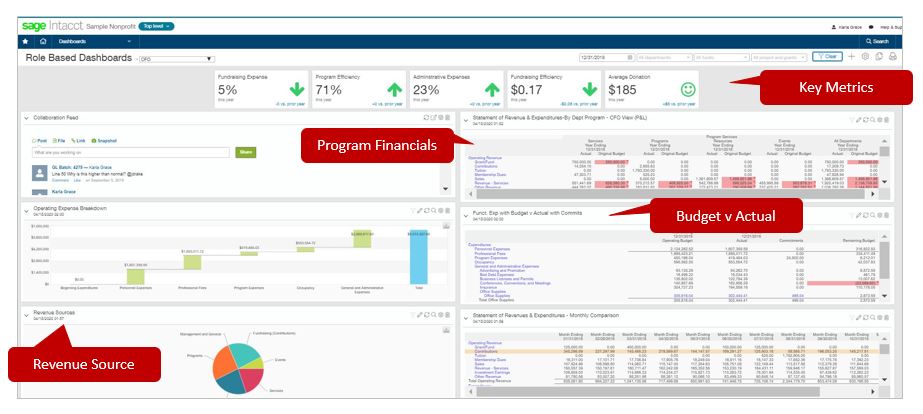Money Matters
How to improve nonprofit storytelling using data and performance metrics

A recent analysis of giving trends shows that the number of individual donors has fallen below 70% of overall giving for the first time since 1954[1]. With fewer individuals donating to charitable organizations, it’s more important than ever to nurture donors who already know and support you. Donor engagement is critical to the success of your mission in the best of financial times—and has the potential to play an even greater role in today’s uncertain outlook.
A recent NPR article reported that a coalition of national nonprofit groups have asked Congress for $60 billion in emergency funding to support charitable organizations nationwide as well as new tax breaks to boost individual giving. Even though funding is expected to decline, community need is on the rise. For example, about one in three people seeking groceries at nonprofit food pantries in March 2020 had never previously needed emergency assistance.
With the short- and mid-term economic outlook uncertain, it’s more important than ever for nonprofit organizations to increase engagement efforts, nurture major donors, and find new and creative ways to connect with potential donors.
Why nonprofit storytelling is an effective way to attract donors
Relationships matter. Despite the decline in the number of people giving, those who give tend to give more. That’s why it’s important for nonprofits to understand the types of research donors conduct before they choose to give, generational differences that affect donations, and what donors want and don’t want from charitable organizations.
“When things went south in 2008, many donors trimmed their giving portfolios in terms of the number of groups they were supporting. The organizations that made the cut often received larger gifts than before. You want to be in your donors’ top three philanthropic priorities, and that starts with relationships.”
2020 Fundraising Trends, Campbell & Company [2]
Recent surveys suggest that donors want nonprofit organizations to focus on making a compelling case of extraordinary need.[3] To fill this need, many leading organizations leverage nonprofit storytelling to communicate with existing and potential donors. Nonprofit storytelling can be employed to make emotional connections, strengthen donor relationships, and demonstrate the effectiveness of your mission.
On a larger scale, it’s important to share your vision and build your brand through nonprofit storytelling. Use images, data, and performance metrics to make immediate connections and help donors remember you. Nonprofit storytelling can also be used to achieve more specific short-term goals. For example, a nonprofit could show the impact that the COVID-19 pandemic will have on the organization. Is demand for your services increasing? Give the details of your situation and establish goals. Empower your donors to become part of the story and show them how you can accomplish your goals together.
Craft a Compelling Narrative
Telling your story the right way makes all the difference when it comes down to securing the funding you need or falling short of your goals. To craft your narrative with clarity, try utilizing this storytelling pyramid to organize your message:
- State why your organization exists
- Demonstrate the need for your organization
- Explain your money story
- Share program messages
- Highlight an individual example
Accentuate Your Story with Photos and Brandings
As the old saying goes, “a picture is worth a thousand words.” Use images of the people you are helping, charts showing the number of meals you have served, or show the work that goes on behind the scenes such as staff and volunteers teaming up to plant trees or build houses. One of the most important rules you should follow when selecting and using images is consistency. Visuals should always reinforce your brand; use a specific style, official colors, and font consistently across all image use so your audience can quickly identify and remember you and your mission.
There are other best practices to keep in mind when selecting images to tell your story. Personal photos deliver the most impact because it’s easier for donors to identify with your cause on an individual level. Since there may be other organizations raising funds to address a similar cause, your organization’s story can help you offer donors a fresh perspective—whether it’s a unique portrayal of the mission or highly personal ways of showing your organization’s impact.
“There are times when visuals just speak louder than words. Whether it’s a picture of people being helped or a colorful chart showing the total amount of funds raised, visuals strike a chord.”
Data and Infographics: Telling Your Nonprofits’ Story, GuideStar [4]
Use Outcome Metrics to Lend Credibility to Your Story
An important part of your nonprofit storytelling should leverage performance data and metrics to communicate your priorities, show impact, demonstrate accountability, and measure progress. Every nonprofit collects data—how much money you’ve raised, how much goes directly to services, how many volunteers you have, or how many people you’ve helped. Use that data to maintain credibility and transparency with your donor base or use it to solve a problem. Here is a great example of how Room to Read uses outcome metrics in its marketing messages:

When you link outcome metrics to your mission, your story really comes to life for donors. Here are some examples of how you can add transparency and credibility to your story with financial and operational metrics:
- Meals served – Cost per meal served
- Patients seen – Cost per patient seen per practice area
- Reading levels achieved – Cost per reading level achieved per child
- Animals adopted – Cost of care per animal per day
Having a real-time cloud financial management solution like Sage Intacct makes it easy to collect the metrics needed to tell your donors a compelling story with data. For example, this CFO dashboard provides an instant, visual display with important performance metrics about budgets, revenue, programs and expenses.

“By integrating storytelling into your marketing materials, you can clearly show prospective members your shared values and beliefs in action.”
How Storytelling Can Help Your Nonprofit Grow Its Membership, GuideStar [5]
Share Your Story Through Your Website and Social Media Channels
Once you’ve developed your nonprofit story, a consistent message that reinforces your brand and goals to your audience, it’s important to share it. Make sure your website fits into your story by clearly communicating the problem your organization is trying to solve and how your audience can help.
Use social media to expand your reach and build momentum. Provide interactive content such as polls to show progress toward specific campaign goals or ask individuals to share stories about how they are making a difference. Always make sure your communication platform makes it easy for donors to give. The American Red Cross does a great job of delivering a consistent message across all of its marketing channels:
Conclusion
If you’re looking for new ways to strengthen relationships with your donor base, it’s time to focus on strengthening brand, communication, and donor engagement through nonprofit storytelling. Sage Intacct understands the challenges you’re facing, and we’ve created a new eBook, Nonprofit Storytelling: Using Data and Performance Metrics to Motivate Donors, to help you explore the latest insights about what drives donor decision-making for charitable giving. It also explores practical ways you can nurture your existing donor base and leverage nonprofit storytelling to attract and engage supporters.

[1] Giving USA, “Giving USA: 2019,” 2019
[2] Campbell Group, “2020 Fundraising Trends: The Forecast from Our Executive Team,” January 27, 2020
[3] A Guide to Philanthropy in the U.S. 8th Edition, 2019 CCS Fundraising
[4] GuideStar, Data and Infographics: Telling Your Nonprofits’ Story, 2017
[5] GuideStar, How Storytelling Can Help Your Nonprofit Grow Its Membership, 2019








Ask the author a question or share your advice